|
|
Table of Contents
Bollinger Band Squeeze
What Is a Bollinger Band Squeeze?
A Bollinger Band Squeeze is a condition that occurs when the Bollinger Bands narrow due to decreased volatility. According to John Bollinger, periods of low volatility are often followed by periods of high volatility. Therefore, a volatility contraction or narrowing of the bands can foreshadow a significant advance or decline. Once the squeeze play is on, a subsequent band break signals the start of a new move. A new advance starts with a squeeze and subsequent break above the upper band. A new decline starts with a squeeze and subsequent break below the lower band.
How Do You Set Up the Indicators?
Before looking at the details, let's review some key indicators for this trading strategy. First, for illustration purposes, note that we are using daily prices and setting the Bollinger Bands at 20 periods and two standard deviations, the default settings. These can be changed to suit one's trading preferences or the characteristics of the underlying security. Bollinger Bands start with the 20-day SMA of closing prices. The upper and lower bands are then set two standard deviations above and below this moving average. The bands move away from the moving average when volatility expands and towards the moving average when volatility contracts.
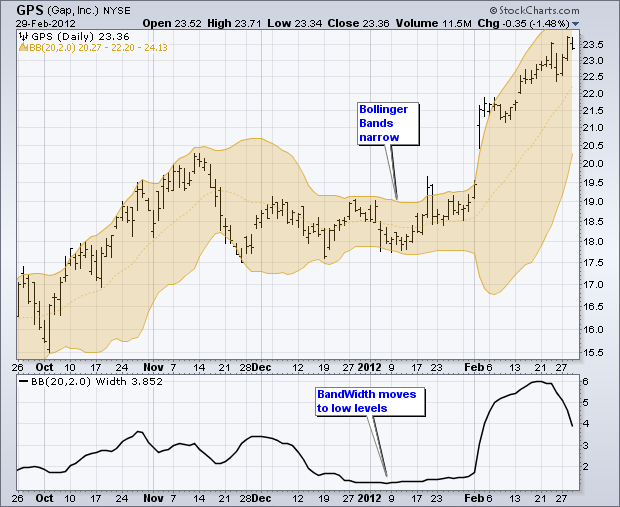
There is also an indicator for measuring the distance between the Bollinger Bands. Appropriately, this indicator is called Bollinger BandWidth, or just the BandWidth indicator. It is simply the value of the upper band less the value of the lower band. Understandably, stocks with higher prices tend to have higher BandWidth readings than stocks with lower prices. If price equals 100 and BandWidth equals 5, then BandWidth would be 5% of the price. If price equals 20 and BandWidth equals 1, then BandWidth would also be 5% of price. Keep this in mind when using the indicator.
How the Strategy Works
The Bollinger Band Squeeze is a straightforward strategy that is relatively simple to implement. First, look for securities with narrowing Bollinger Bands and low BandWidth levels. Ideally, BandWidth should be near the low end of its six-month range. Second, wait for a band break to signal the start of a new move. An upside bank break is bullish, while a downside band break is bearish. Note that narrowing bands do not provide any directional clues. They simply infer that volatility is contracting and chartists should be prepared for a volatility expansion, which means a directional move.
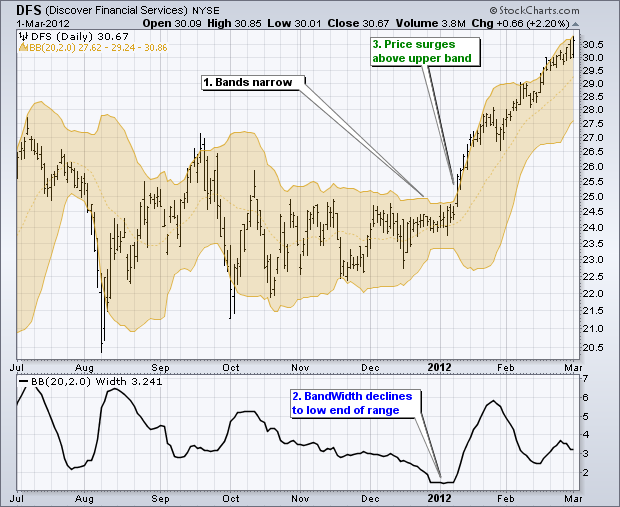
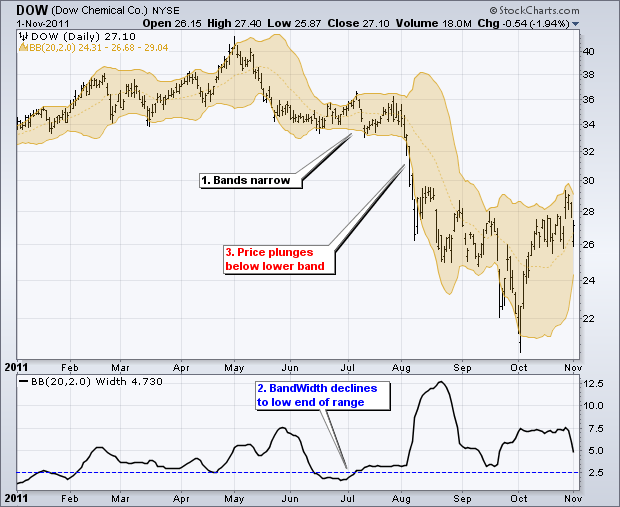
BandWidth Signal Recap:
- Bollinger Bands narrow on the price chart.
- The BandWidth is near the low end of its six-month range.
- Price breaks above the upper band or below the lower band.
Trading Signals
Even though the Bollinger Band Squeeze is straightforward, chartists should at least combine this strategy with basic chart analysis to confirm signals. For example, a break above resistance can be used to confirm a break above the upper band. Similarly, a break below support can be used to confirm a break below the lower band. Unconfirmed band breaks are subject to failure.
The chart below shows Starbucks (SBUX) with two signals within a two-month period, which is relatively rare. After a surge in March, the stock consolidated with an extended trading range. SBUX broke the lower band twice, but did not break support from the mid-March low. Basic chart analysis reveals a falling wedge-type pattern. Notice that this pattern formed after a surge in early March, which makes it a bullish continuation pattern. SBUX subsequently broke above the upper band, then broke resistance for confirmation.
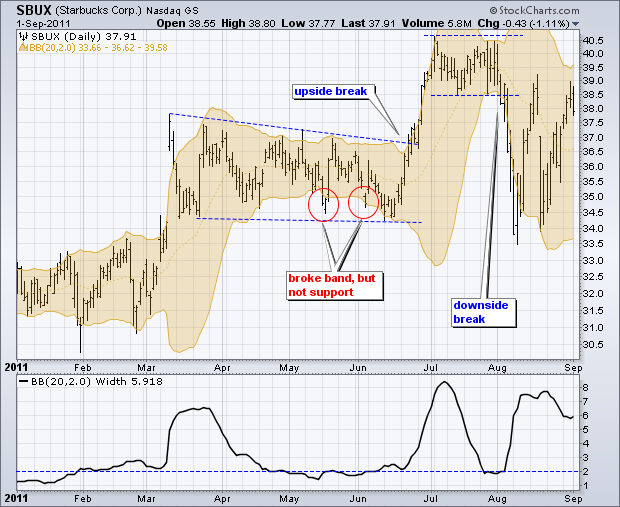
After the surge above 40, the stock again moved into a consolidation phase as the bands narrowed and BandWidth fell back to the low end of its range. Another setup was in the making as the surge and flat consolidation formed a bull flag in July. Despite this bullish pattern, SBUX never broke the upper band or resistance. Instead, SBUX broke the lower band and support, which led to a sharp decline.
Tweaking
Because the Bollinger Band Squeeze does not provide any directional clues, chartists must use other aspects of technical analysis to anticipate or confirm a directional break. In addition to basic chart analysis, chartists can also apply complimentary indicators to look for signs of buying or selling pressure within the consolidation. Momentum oscillators and moving averages are of little value during a consolidation because these indicators simply flatten along with price action. Instead, chartists should consider using volume-based indicators, such as the Accumulation Distribution Line, Chaikin Money Flow, the Money Flow Index (MFI) or On Balance Volume (OBV). Signs of accumulation increase the chances of an upside breakout, while signs of distribution increase the chances of a downside break.
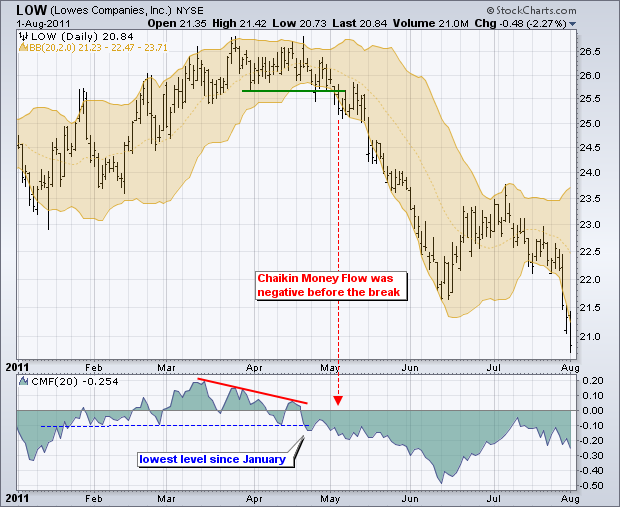
The chart above shows Lowes Companies (LOW) with the Bollinger Band Squeeze occurring in April 2011. The bands moved to their narrowest range in months as volatility contracted. The indicator window shows Chaikin Money Flow weakening in March and turning negative in April. Notice that CMF reached its lowest level since January and continued lower into early May. Negative readings in Chaikin Money Flow reflect distribution or selling pressure that can be used to anticipate or confirm a support break in the stock.
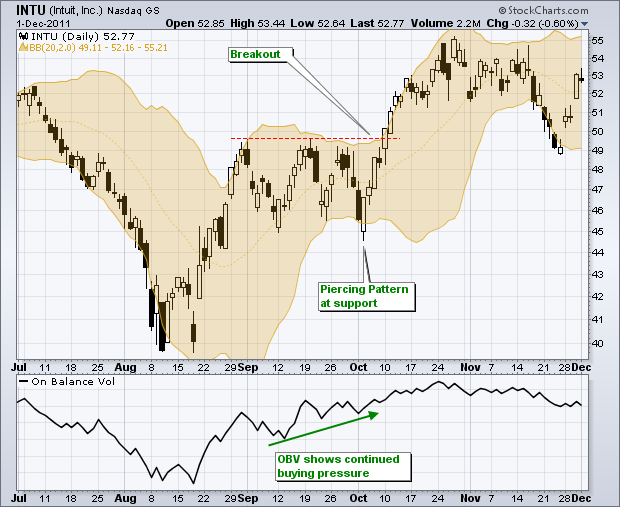
The example above shows Intuit (INTU) with a Bollinger Band Squeeze in September and breakout in early October. During the squeeze, notice how On Balance Volume (OBV) continued to move higher, which showed accumulation during the September trading range. Signs of buying pressure or accumulation increased the chances of an upside breakout.
Before breaking out, the stock opened below the lower band and then closed back above the band. Notice that a piercing pattern formed, which is a bullish candlestick reversal pattern. This pattern reinforced support and the follow-through foreshadowed the upside breakout.
The Head Fake
In his book, Bollinger on Bollinger Bands, John Bollinger advises chartists to beware of the “head fake.” This occurs when prices break a band, then suddenly reverse and move the other way, similar to a bull or bear trap. A bullish head fake starts when Bollinger Bands contract and prices break above the upper band. This bullish signal does not last long because prices quickly move back below the upper band and proceed to break the lower band. A bearish head fake starts when Bollinger Bands contract and prices break below the lower band. This bearish signal does not last long because prices quickly move back above the lower band and proceed to break the upper band.
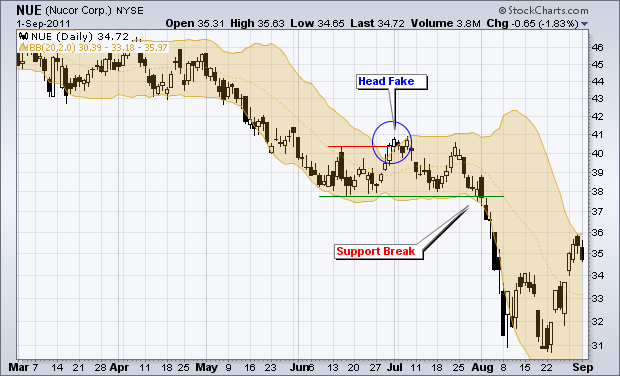
The Bottom Line
The Bollinger Band Squeeze is a trading strategy designed to find consolidations with decreasing volatility. In its purest form, this strategy is neutral and the ensuing break can be up or down. Chartists, therefore, must employ other aspects of technical analysis to formulate a trading bias to act before the break or confirm the break. Acting before the break will improve the risk-reward ratio. Keep in mind that this article is designed as a starting point for trading system development. Use these ideas to augment your trading style, risk-reward preferences and personal judgments. Click here for a chart of the S&P 500 ETF with Bollinger Bands and the BandWidth indicator.
Suggested Scans
Bollinger Band Squeeze
This scan divides the difference between the upper band and the lower band by the closing price, which shows BandWidth as a percentage of price. In general, BandWidth is narrow when it is less than 4% of price. Chartists can use higher levels to generate more results or lower levels to generate fewer results.
[type = stock] and [country = us] and [daily sma(20,daily volume) > 100000] and [daily sma(60,daily close) > 20] and [[[Upper BB (20,2) - Lower BB (20,2)] / Close ] < .04]
Bollinger Band Squeeze FAQs
What is the Bollinger Band Squeeze?
The Bollinger Band Squeeze is a trading strategy that identifies periods when the Bollinger Bands narrow due to low volatility, indicating potential significant price movements in the near future.
What happens after a Bollinger Band Squeeze?
According to John Bollinger, after periods of low volatility (and a squeeze), a subsequent band break signals the start of a significant price move, either upwards (breaking the upper band) or downwards (breaking the lower band).
Is the Bollinger Band Squeeze a directional strategy?
No, the Bollinger Band Squeeze itself does not provide directional clues. It only indicates a pending volatility expansion. Other technical analysis tools are needed to determine the potential direction of the breakout.
How can traders confirm Bollinger Band breaks?
Breaks can be confirmed using basic chart analysis, such as observing a break above a known resistance or below a support level. Unconfirmed band breaks are more prone to failure.
Are there other indicators that can be used alongside the Bollinger Band Squeeze?
Yes, volume-based indicators like the Accumulation Distribution Line, Chaikin Money Flow, Money Flow Index, or On Balance Volume can be beneficial. These can help determine signs of buying or selling pressure within the consolidation.
